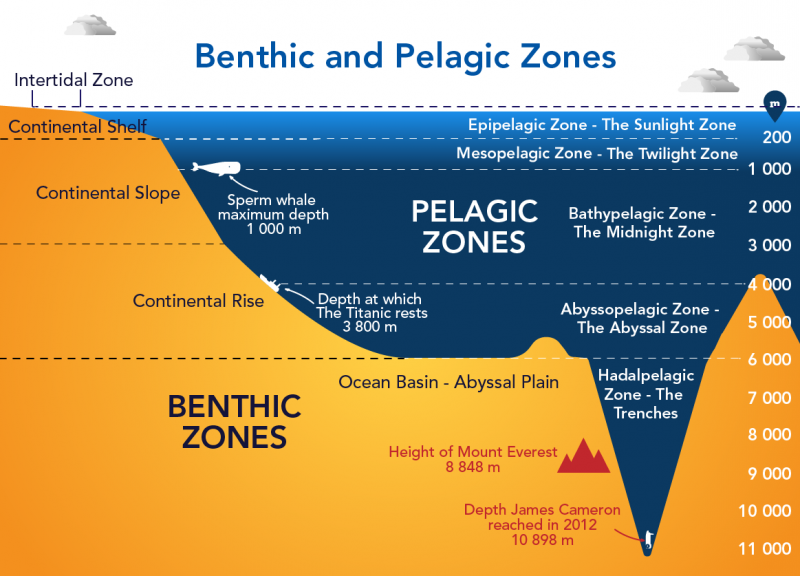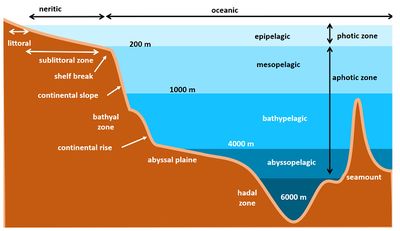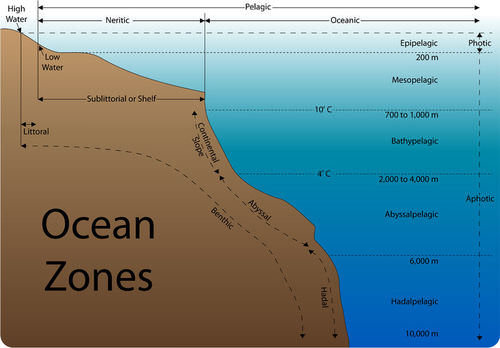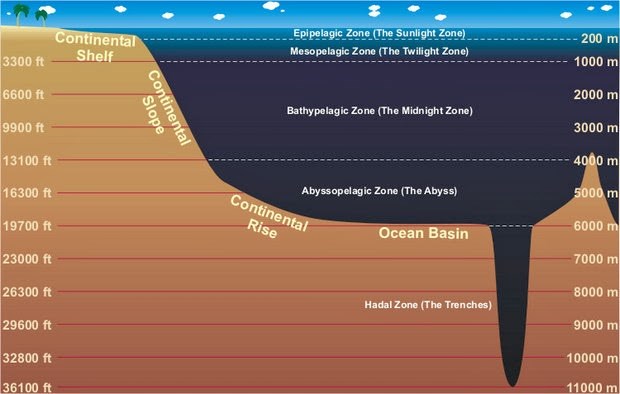Describe the Zones of the Open Ocean
The mesopelagic zone extends from 200 m to 1000 m. Estuaries salt marshes mangrove forests coral reefs the open ocean and the deep-sea ocean.

Ocean Zones Let S Talk Science
The open ocean is further divided into two large zones.

. The water environment of this region collectively referred to as thepelagic zoneis further subdivided into theepipelagic mesopelagic bathypelagic and benthopelagic zones. The benthic zone is the ocean bottom. Which phrases describe the open-ocean zone.
Far from the shore. Demersal zone forms a layer of a large weak area. The epipelagic extends from the water surface down to a depth of 200 metres.
Otherwise known as the sunlight zone twilight zone midnight zone the abyss and the trenches. The bathypelagic zone from 1000 m to 4000 m. The benthic and the pelagic zones.
0 650 0 200. Lots of sunlight and low pressure. Its where youll find some of the biggest marine life species.
This is the zone in which photosynthesis can occur because light is. The pelagic zone is all the water above the ocean bottom. The pelagic zone is the area of the ocean outside of coastal areas.
The water overlying the continental shelf. The bathypelagic zone or lower open ocean 3300-13000 feet deep. This upper layer which is influenced by light is especially productive because the primary producers algae cyanobacteria and seagrass produce.
The Ocean Zones Ocean Sunlight Zone. Two subdivision are recognized. According to Zobell 1963 the density of bacteria in sea water ranges from less than one per litre in the open ocean to a maximum of 10 per ml inshore.
With the exception of Antarctica these waters usually extend to a depth of. The sea area is the open sea water of the world which is closed off from all the continents. Clams mussels and oysters retreat into their shells at low tide.
Sunlight Zone This zone extends from the surface down to about 700. The ocean is divided into five zones. And the hadopelagic zone or deep ocean trenches 20000 feet and deeper.
The photic zone is also known as the epipelagic zone. Check all that apply. The open ocean is known as the pelagic pi-LAJ-ik zone and the ocean bottom is known as the benthic zone.
Located seaward of the coastal zones low-tide mark this contains the vast open waters of the ocean. The open ocean lies over and beyond the continental shelf. On the continental slope or over abyssal plains divided into 4 zones Epipelagic Zone 90 of all ocean life.
And abyssalpelagic zone is deeper than 4000 m. Although there is some disagreement several types of marine ecosystems are largely agreed on. Bathypelagic zone 1000-4000m - This is a.
The demersal zone is a part of the water column near the seabed and the benthos. An estuary is a coastal zone where oceans meets rivers. Plankton and jellyfish are drifters that inhabit this zone.
The pelagic zone is further divided based on the depth and relative penetration of. What is the three temperature zone of the ocean. The ocean is divided into different depth zones.
Crabs avoid dehydration by burrowing into the sand or mud. The Epipelagic zone the Mesopelagic zone Bathypelagic zone Abyssopelagic zone and the hadalpelagic hadal zone. Aptly named for its position at the surface level this sunlight zone also called the surface zone.
The epipelagic zone or upper open ocean surface to 650 feet deep. Click card to see definition Pelagic- open ocean water Benthic- sea floor at all depths Neritic- area seaward from shore across from continental shelf to shelf break of 120-200 m Click again to see term 162 YOU MIGHT ALSO LIKE. In the open ocean.
Demersal zone This type of zone is considered to be a part of the sea. The sunlit zone is where photosynthesis takes place. The word comes from the Greek terms pélagos open sea and epí upon.
The ocean water column is made up of 5 zones. The open ocean zone lies beyond the continental slope and contains 65 of the water in the oceans. The twilight zone or the mesopelagic zone begins at 200 meters and extends downward to 1000.
The sunlight zone the twilight zone the midnight zone the abyss and the trenches. This is also called the open ocean. The most variable temperatures depending on location and proximity to the ocean surface which allows light and consequently heat to penetrate.
The deep oceanthe third. First I should probably say that there are 5 zones of the ocean not 3. This type of zone is above the benthic zone.
This zone is divided further into three subzones. The mesopelagic zone or middle open ocean 650-3300 feet deep. This ocean layer has the most visible light and warmest temperatures hence its nickname.
Gravity Describe the portions of the ocean represented by the pelagic benthic and neritic zones. Mesopelagic zone 200-1000m - This is also known as the twilight zone because light becomes limited. The sea floor demersal zone is.
Also known as littoral nearshore and intertidal zone. The Intertidal Zone Organisms in the intertidal zone are adapted to periodic exposure to air during low tide. Area in a body of water that is deeper than 200 meters where sunlight does not penetrate to allow photosynthesis to take place.
The decomposers of the neritic zone are largely bacteria. The abyssopelagic zone or abyss 13000-20000 feet deep. In marine biomes the narrow strip along the coastline that is covered by water at high tide and exposed to air at low tide.
Low temp few nut little sun. The open ocean habitat or theoceanic zone generally begins at the outer edge of thecontinental shelf extending from the surface down to the deepest depths of the ocean. There are three major zones Surface Zone Thermocline Zone The Deep.
Top zone of the ocean The sunlight zone. The Pelagic zone is the open ocean and the Benthic zone is the ocean bottom. The region of the open sea beyond the continental shelf is designated as the oceanic zone.
Its the thinnest layer accounting for just 5 of the ocean depth. Pelagic refers to the open ocean and thus excludes areas that are near to the shores or the ocean. Open Ocean Epipelagic zone ocean surface to 200 meters deep.
Very little sunlight few nutrients low temperatures low density located near coasts 2 See answers Advertisement Advertisement atownsend424 atownsend424 Answer. Most animals living in the open ocean live in the sunlit zone. Marine life is restricted to the photic zone.

Open Ocean Habitat Marinespecies Introduced Traits Wiki

Ocean Zones Read Earth Science Ck 12 Foundation

Open Ocean Oceans Coasts Seashores U S National Park Service
No comments for "Describe the Zones of the Open Ocean"
Post a Comment